check engine Citroen DS5 2012 1.G User Guide
[x] Cancel search | Manufacturer: CITROEN, Model Year: 2012, Model line: DS5, Model: Citroen DS5 2012 1.GPages: 348, PDF Size: 10.47 MB
Page 99 of 348
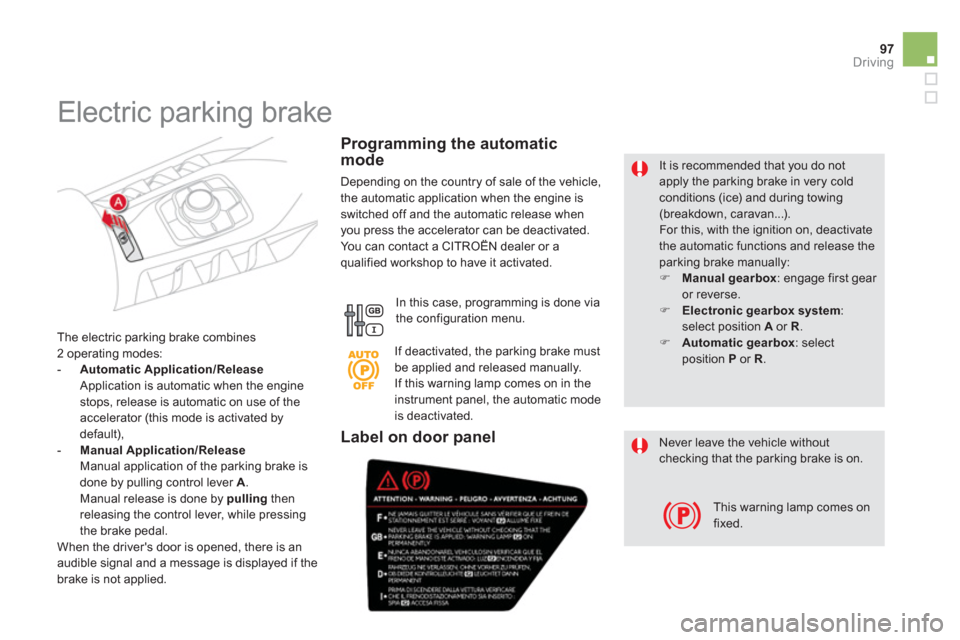
97
Driving
It is recommended that you do not apply the parking brake in very coldconditions (ice) and during towing (breakdown, caravan...). For this, with the ignition on, deactivate the automatic functions and release theparking brake manually:�)Manual gearbox:
engage first gear or reverse. �)Electronic gearbox system
: select position Aor R.�)
Automatic gearbox: select position Por R.
The electric parking brake combines2 operating modes:
-
Automatic Application/Release Application is automatic when the engine stops, release is automatic on use of the accelerator (this mode is activated by
default), -Manual Application/Release Manual application of the parking brake is done by pulling control lever A. Manual release is done by pulling
thenreleasing the control lever, while pressing
the brake pedal.
When the driver's door is opened, there is an
audible si
gnal and a message is displayed if the
brake is not applied.
Programming the automatic
mode
Depending on the country of sale of the vehicle,
the automatic application when the engine is switched off and the automatic release when
you press the accelerator can be deactivated.
You can contact a CITROËN dealer or a qualified workshop to have it activated.
In this case, pro
gramming is done via
the configuration menu.
Electric parking brake
If deactivated, the parking brake must
be applied and released manually.
If this warning lamp comes on in the instrument panel, the automatic modeis deactivated.
Never leave the vehicle withoutchecking that the parking brake is on.
This warning lamp comes onfixed.
Label on door panel
Page 100 of 348
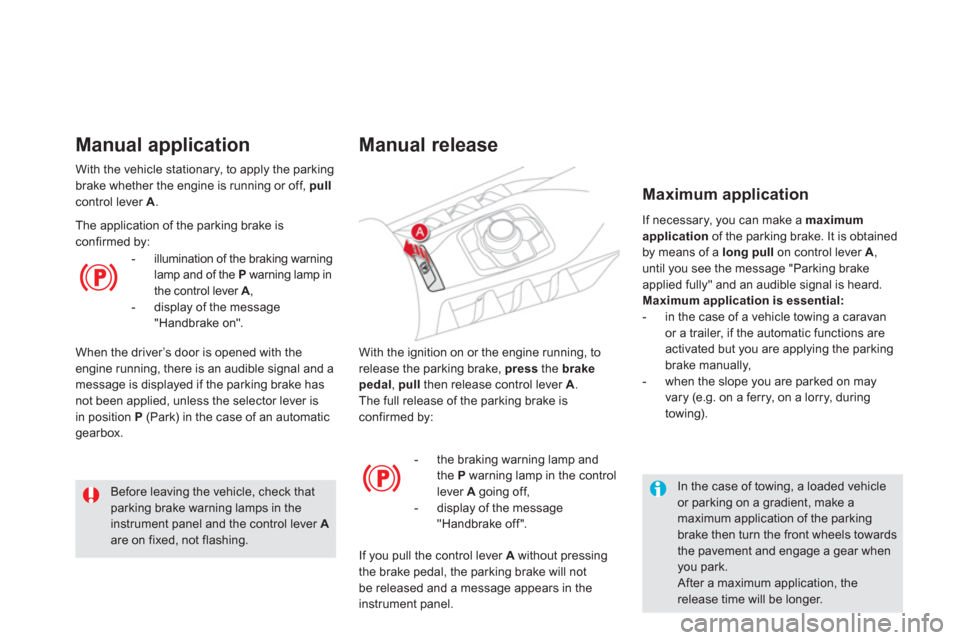
With the ignition on or the engine running, torelease the parking brake, press the brakepedal, pullthen release control lever A.
The full release of the parking brake isconfirmed by:
Manual release
- the braking warning lamp and
the Pwarning lamp in the control lever A going off,
- display of the message "Handbrake off".
I
f you pull the control lever A
without pressing
the brake pedal, the parking brake will not
be released and a message appears in the
instrument panel.
I
f necessary, you can make a maximum application
of the parking brake. It is obtained
by means of a long pull
on control lever A
,
until you see the message "Parking brake
applied fully" and an audible signal is heard.
Maximum application is essential:
- in the case of a vehicle towing a caravan
or a trailer, if the automatic functions are activated but you are applying the parking
brake manually,
- when the slope
you are parked on may
vary (e.g. on a ferry, on a lorry, duringtowing).
Maximum application
In the case of towing, a loaded vehicle or parking on a gradient, make amaximum application of the parking brake then turn the front wheels towardsthe pavement and engage a gear when you park.
After a maximum application, therelease time will be longer.
Before leaving the vehicle, check thatparking brake warning lamps in the instrument panel and the control lever Aare on fixed, not flashing.
With the vehicle stationary, to apply the parkingbrake whether the engine is running or off, pullcontrol lever A.
Manual application
The application of the parking brake is confirmed by:
- illumination of the brakin
g warning
lamp and of the P warning lamp in
the control lever A,
- display of the message "Handbrake on".
When the driver
’s door is opened with the engine running, there is an audible signal and amessage is displayed if the parking brake has not been applied, unless the selector lever is
in position P (Park) in the case of an automatic
gearbox.
Page 101 of 348
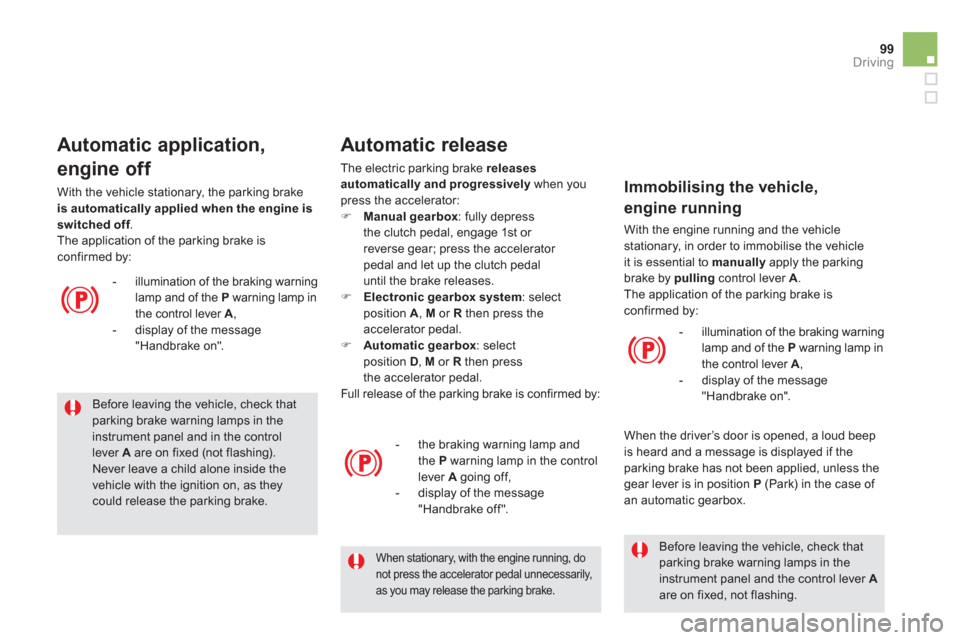
99Driving
Before leaving the vehicle, check that parking brake warning lamps in the instrument panel and in the control lever Aare on fixed (not flashing).
Never leave a child alone inside thevehicle with the ignition on, as they could release the parking brake.
Automatic application,
engine off
- illumination of the braking warning
lamp and of the Pwarning lamp in
the control lever A ,
- display of the message "Handbrake on". With the vehicle stationar
y, the parking brake is automatically applied when the engine is
switched off. The application of the parking brake is confirmed by:
Automatic release
The electric parking brake releasesautomatically and progressively
when you press the accelerator:�)Manual gearbox
: fully depress
the clutch pedal, engage 1stor reverse gear; press the accelerator
pedal and let up the clutch pedal until the brake releases.�)Electronic gearbox system: select position A, M or R
then press the
accelerator pedal.
�)Automatic gearbox: select
position D , M or Rthen press
the accelerator pedal.
Full release of the parkin
g brake is confirmed by:
- the brakin
g warning lamp and
the P warning lamp in the control
lever Agoing off,
- display of the message
"Handbrake off".
When stationary, with the engine running, do not press the accelerator pedal unnecessarily,
as you may release the parking brake.
Before leaving the vehicle, check that parking brake warning lamps in the instrument panel and the control lever Aare on fixed, not flashing.
Immobilising the vehicle,
engine running
With the engine running and the vehicle stationary, in order to immobilise the vehicleit is essential to manuallyapply the parking brake by pullingcontrol lever A.
The application of the parking brake isconfirmed by:
- illumination o
f the braking warninglamp and of the P
warning lamp in
the control lever A,
- display of the message"Handbrake on".
When the driver’s door is opened, a loud beep
is heard and a messa
ge is displayed if the
parking brake has not been applied, unless the gear lever is in position P(Park) in the case of
an automatic gearbox.
Page 105 of 348

103Driving
SituationsConsequences
To a p p ly the electric parking brake: �)
immobilise the vehicle and switch off the ignition. �)
pull the control for at least 5 seconds or until application is complete.�)
switch on the ignition and check that the electric parking brake
warning lamps come on.
The application is slower than during normal operation.
To release the electric parking brake:�) switch on the ignition. �)
pull the control lever and hold it for approximately 3 seconds then
release it.
If the braking warning lamp is flashing or if the warning lamps do not come on with the ignition on, these procedures will not work. Place the
vehicle on level ground and have it checked by a CITROËN dealer or aqualified workshop. and possibl
y
flashin
g
Display of the message "Parking brake fault" and of the followingwarning lamps:
- Only the automatic application on switching off the engine andautomatic release on acceleration functions are available.
- The manual application/release of the electric parking brake and theemergency braking are not available.
an
d possibly
flashin
g
Display of the message "Batter y charge fault".
- You must stop as soon as it is safe to do so. Switch off and
immobilise your vehicle (if necessary, place the a chock under a
wheel).
- Apply the electric parking brake before switching off the engine.
Page 107 of 348
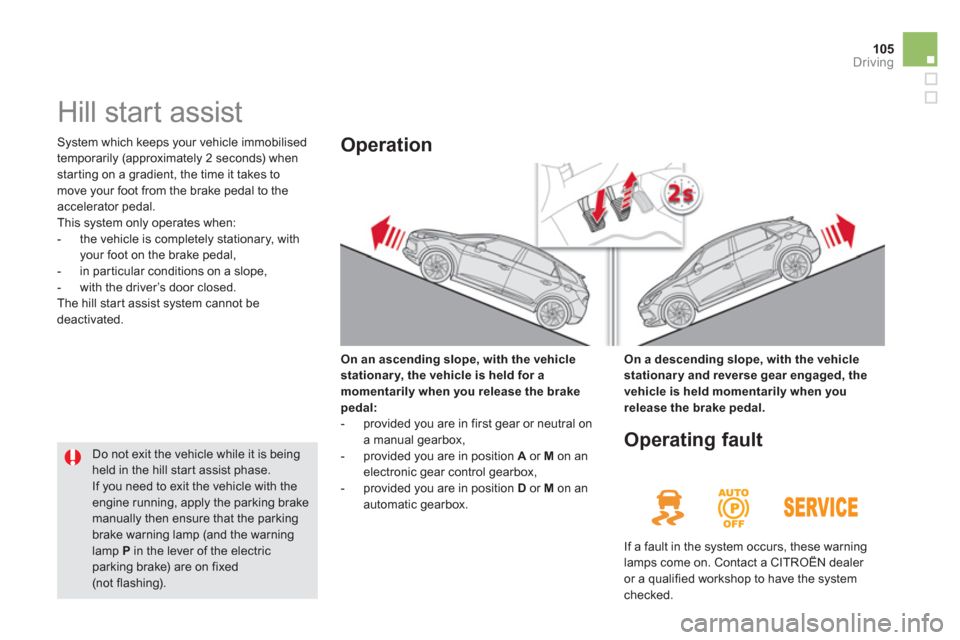
105
Driving
Hill start assist
System which keeps your vehicle immobilised
temporarily (approximately 2 seconds) whenstarting on a gradient, the time it takes to move your foot from the brake pedal to the
accelerator pedal.
This s
ystem only operates when:
- the vehicle is completely stationary, with your foot on the brake pedal,
- in par ticular conditions on a slope,
- with the driver’s door closed.
The hill star t assist system cannot be
deactivated.
On an ascendin
g slope, with the vehicle
stationary, the vehicle is held for amomentarily when you release the brake
pedal:- provided you are in first gear or neutral on
a manual
gearbox,
- provided you are in position A
or M
on an electronic gear control gearbox,
- provided you are in position D
or M
on an
automatic gearbox.
Operation
On a descending slope, with the vehicle
stationary and reverse gear engaged, thevehicle is held momentarily when you
release the brake pedal.
Do not exit the vehicle while it is beingheld in the hill star t assist phase.
If you need to exit the vehicle with the engine running, apply the parking brake manually then ensure that the parking brake warning lamp (and the warninglamp P
in the lever of the electricparking brake) are on fixed(not flashing).
Operating fault
If a fault in the system occurs, these warning
lamps come on. Contact a CITROËN dealer or a qualified workshop to have the systemchecked.
Page 113 of 348
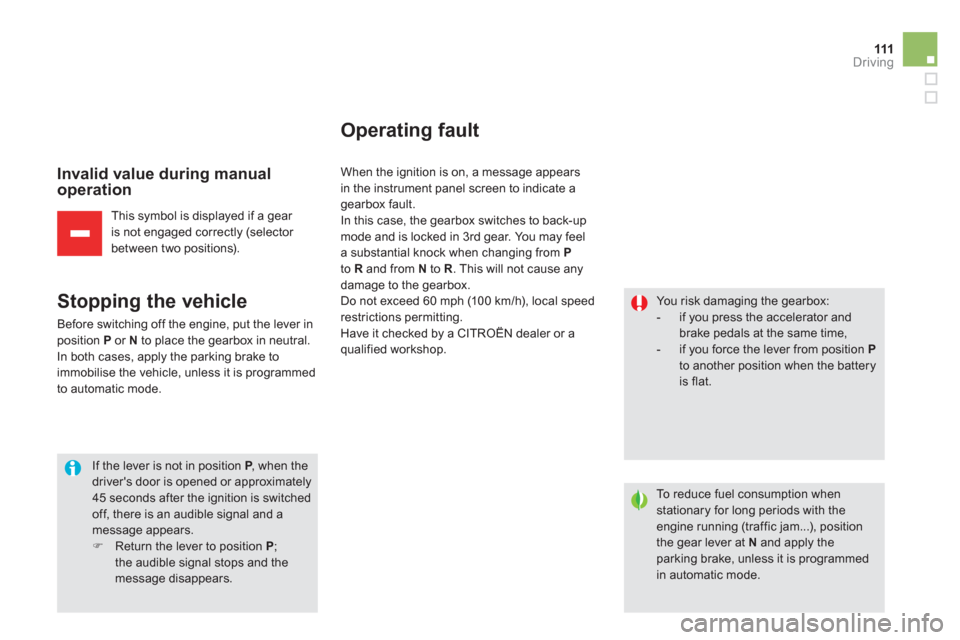
111Driving
Invalid value during manual
operation
This symbol is displayed if a gear
is not engaged correctly (selector
between two positions).
Stopping the vehicle
Before switching off the engine, put the lever in position Por N
to place the gearbox in neutral.
In both cases, apply the parking brake toimmobilise the vehicle, unless it is programmed
to automatic mode.
If the lever is not in position P
, when thePdriver's door is opened or approximately45 seconds after the ignition is switched off, there is an audible signal and amessage appears. �)
Return the lever to position P
; the audible signal stops and the message disappears.
Operating fault
When the ignition is on, a message appears in the instrument panel screen to indicate agearbox fault.
In this case, the gearbox switches to back-up
mode and is locked in 3rd
gear. You may feel a substantial knock when changing from Pto R
and from Nto R. This will not cause anydamage to the gearbox.
Do not exceed 60 mph (10 0 km/h), local speedrestrictions permitting.
Have it checked by a CITROËN dealer or aqualified workshop.
You risk damaging the gearbox:
- if you press the accelerator and brake pedals at the same time,
- if you force the lever from position Pto another position when the batteryis flat.
To reduce fuel consumption whenstationary for long periods with theengine running (traffic jam...), position
the gear lever at Nand apply theparking brake, unless it is programmed in automatic mode.
Page 117 of 348

115
Driving
You must press the brake pedal when starting the engine.
Whatever the circumstances, you mustmanually apply the parking brake when parking, unless the parking brake is programmed in automatic mode.
When immobilising the vehicle, with the engine running, you must place the gear lever in neutral N.Before carrying out any work in the engine compar tment, check that the gear lever is in neutral N
and that the parking brake is applied.
Stopping the vehicle
With the ignition on, the flashing of this warning lamp,
accompanied by an audible signal and a message
in the instrument panel screen, indicates a
mal
function of the gearbox.
Have it checked by CITROËN or a qualified
workshop. Be
fore switching off the engine, you canchoose to:
- move to position N
to engage neutral,
- leave the gear engaged; in this case, it will
not be possible to move the vehicle.
In both cases, you should apply the parking brake to immobilise the vehicle.
Operating fault
Sport setting
�)
After selection of manual or
automated mode, press the Sbutton to switch on the Sport setting, which provides a more
dynamic driving style.S appears alongside the gear engaged in the instrument panelscreen.
�)Press the Sbutton again to switch it off. Sthen disappears from the instrument panel screen.
The Spor t setting is switched off every time the
ignition is switched off.
Page 120 of 348
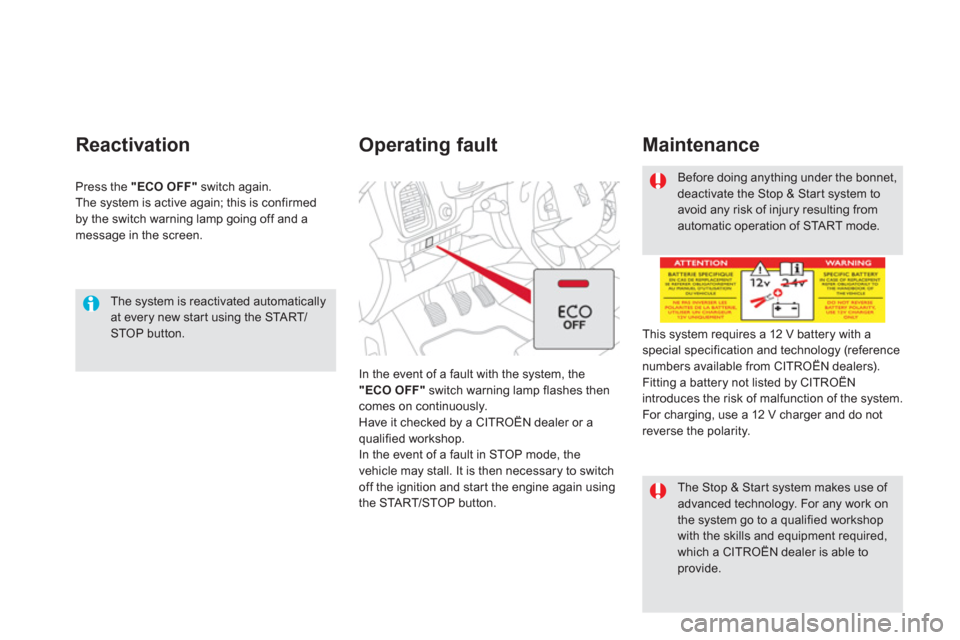
The system is reactivated automaticallyat every new star t using the STA R T/STOP button.
Reactivation
Press the "ECO OFF"switch again.
The system is active again; this is confirmed
by the switch warning lamp going off and a
message in the screen.
Operating fault
In the event of a fault with the system, the
"ECO OFF"
switch warning lamp flashes thencomes on continuously.
Have it checked by a CITROËN dealer or aqualified workshop.
In the event of a fault in STOP mode, the
vehicle may stall. It is then necessary to switch
off the ignition and star t the engine again using
the STA R T/STOP button.
Before doing anything under the bonnet,deactivate the Stop & Start system toavoid any risk of injury resulting from automatic operation of START mode.
This s
ystem requires a 12 V battery with a special specification and technology (reference numbers available from CITROËN dealers).
Fitting a battery not listed by CITROËN
introduces the risk of malfunction of the system.
For charging, use a 12 V charger and do not
reverse the polarity.
Maintenance
The Stop & Star t system makes use of advanced technology. For any work onthe system go to a qualified workshop with the skills and equipment required, which a CITROËN dealer is able toprovide.
Page 171 of 348

Safety
Dynamic stability control (DSC)
Activation
This system is activated automatically eachtime the vehicle is started.
It comes into operation in the event of a grip or
tra
jectory problem.
This is indicated by
flashing of thiswarning lamp in the instrument panel.
Deactivation
In exceptional conditions (starting a vehicle
which is bogged down, stuck in snow, on soft ground...), it may be advisable to deactivate
the DSC system, so that the wheels can move freely and regain grip.
The DSC system offers exceptional
safety in normal driving, but this should not encourage the driver to take extra risks or drive at high speed.
The correct operation of the system depends on obser vation of the manufacturer's recommendationsregarding the wheels (tyres and rims),the braking components, the electronic components and the CITROËN assembly and operation procedures.
After an impact, have the systemchecked by a CITROËN dealer or a qualified workshop.
Operating fault
If this warning lamp comes on,
accompanied by an audible signal
and a message in the instrument
panel screen, this indicates a fault
with the s
ystem.
Contact a CITROËN dealer or a qualifiedworkshop to have the system checked.
Reactivation
The system is reactivated automatically each
time the ignition is switched back on or from 30 mph (50 km/h).
�) Press the button.
This warnin
g lamp and the indicator
lamp in the button come on:
the DSC s
ystem no longer acts on
the operation of the engine.
�)
Press the button again to
reactivate it manually. But it is recommended that the s
ystem be
reactivated as soon as possible.
Page 184 of 348

1. Sealing
�)Switch off the ignition.�)Turn the selector Ato the "sealant"position.�)Check that the switch B
is in
position "O" .
�)
Uncoil the white pipe G
fully.�)
Unscrew the cap from the white pipe.�)
Connect the white pipe to the valve of the
tyre to be repaired.
�)Connect the compressor's electric plug to
the vehicle's 12 V socket. �)Star t the vehicle and leave the engine running.
Take care, this product is harmful(e.g. ethylene-glycol, colophony...) if swallowed and causes irritation to the eyes.Keep it out of reach of children.
Do not star t the compressor before connecting the white pipe to the tyre valve: the sealant product would be expelled through the pipe.
Avoid removing any foreign bodieswhich have penetrated into the tyre.